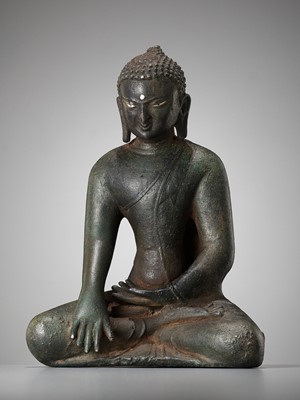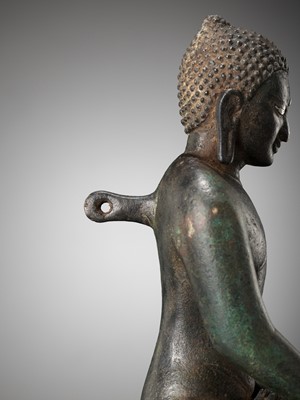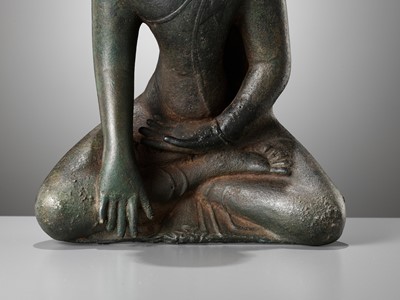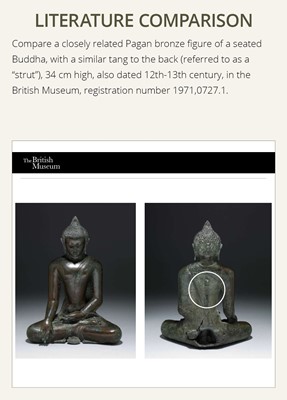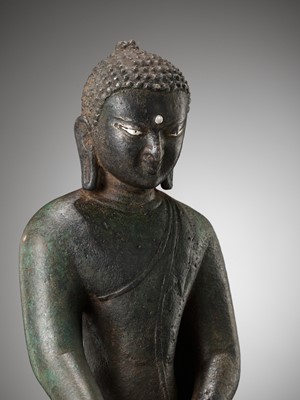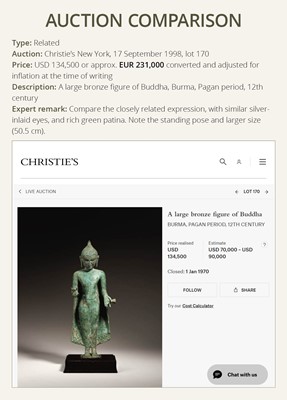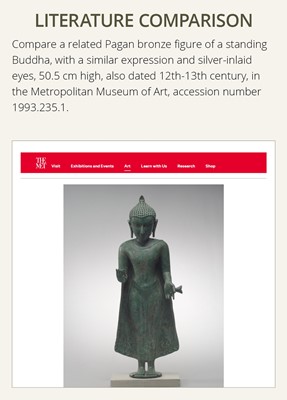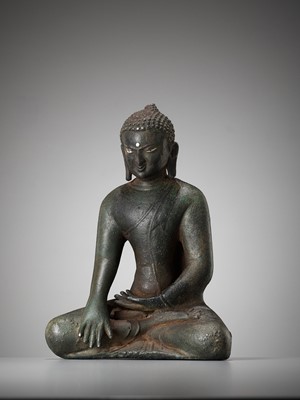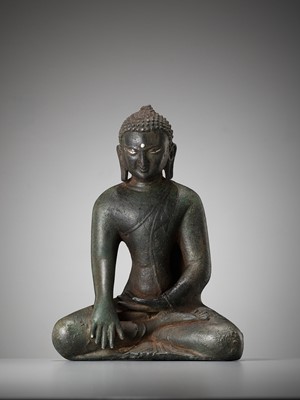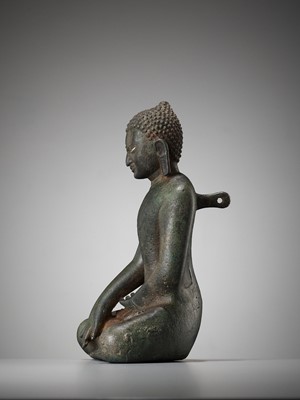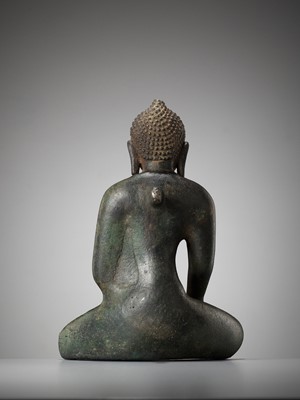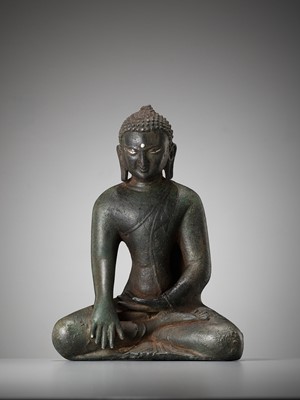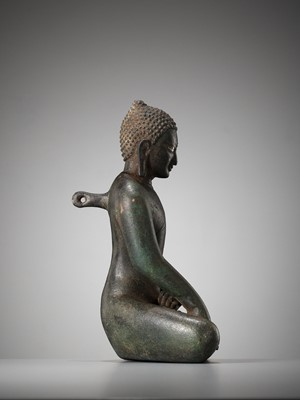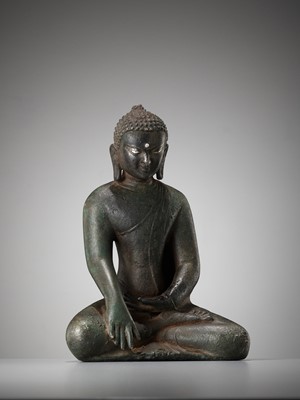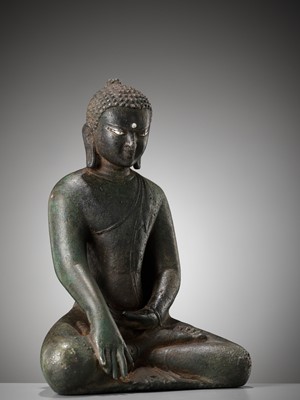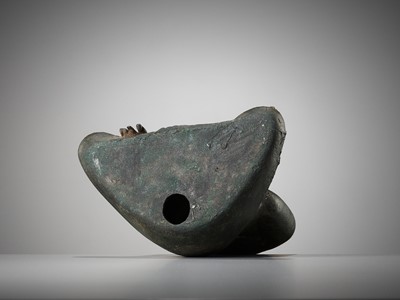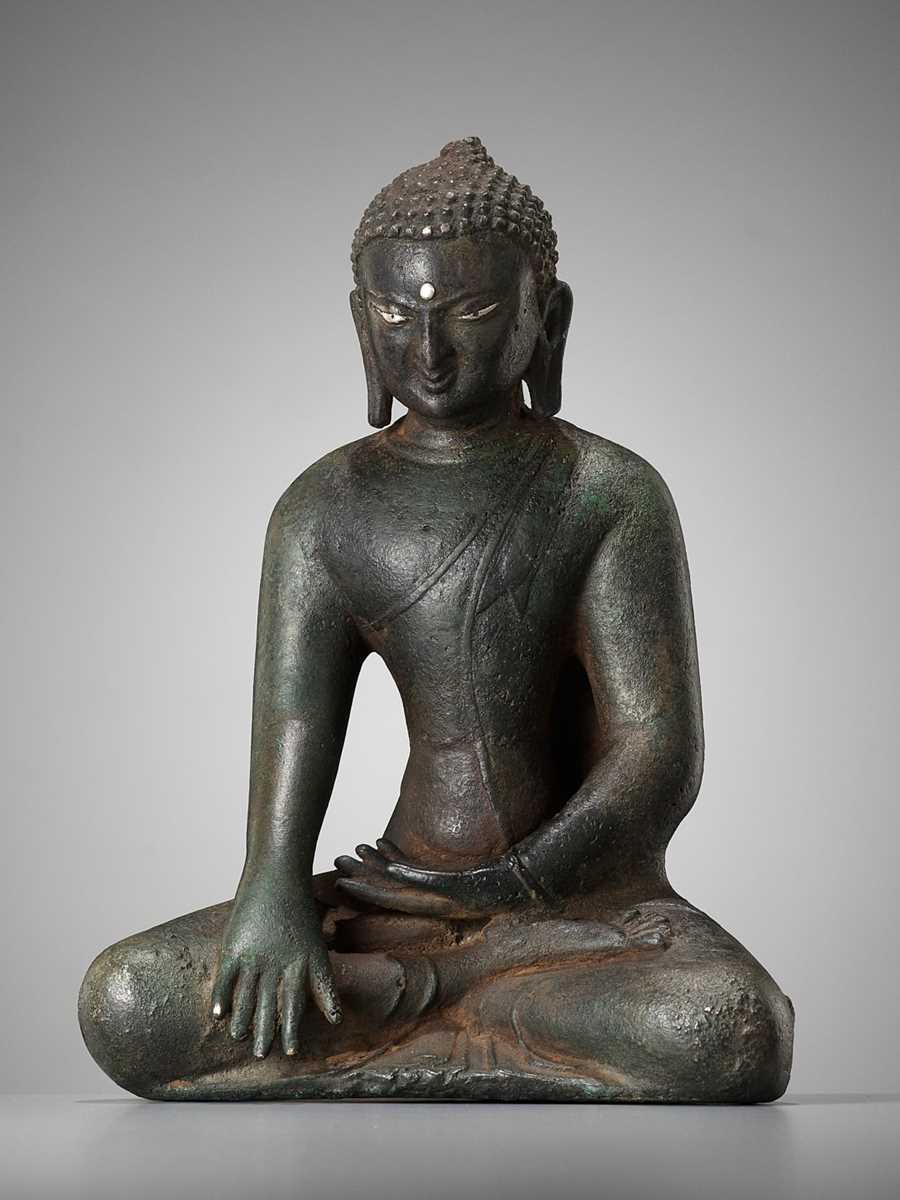9th Mar, 2023 13:00
TWO-DAY AUCTION - Fine Chinese Art / 中國藝術集珍 / Buddhism & Hinduism
251
A SILVER-INLAID BRONZE FIGURE OF BUDDHA SHAKYAMUNI, PAGAN KINGDOM
Sold for €9,750
including Buyer's Premium
Burma, 12th-13th century. Finely cast seated in dhyanasana with his left hand resting in his lap and the right lowered in bhumisparsha mudra. He is wearing a diaphanous sanghati draped over his left shoulder and with folds gathering below his feet. His oval face with silver-inlaid almond-shaped eyes and a circular urna, aquiline nose, and pursed lips forming a serene smile, flanked by long pendulous earlobes, his hair arranged in tight curls rising to a domed ushnisha. The back with a long and massive tang.
Provenance: English trade.
Condition: Good condition, commensurate with age. Extensive wear and weathering as expected, some losses with associated old fills mostly around the base, casting flaws, foundry grit, nicks and dents, shallow surface scratches, encrustations. Naturally grown, rich malachite-green patina overall.
Weight: 3,408 g
Dimensions: Height 26 cm
The Kingdom of Pagan was the first Burmese kingdom to unify the regions that would later constitute modern-day Myanmar. Pagan's 250-year rule over the Irrawaddy valley and its periphery laid the foundation for the ascent of Burmese language and culture, the spread of Bamar ethnicity in Upper Myanmar, and the growth of Theravada Buddhism in Myanmar and in mainland Southeast Asia. The Burmese language and culture gradually became dominant in the upper Irrawaddy valley, eclipsing the Pyu, Mon, and Pali norms by the late 12th century. Theravada Buddhism slowly began to spread to the village level although Tantric, Mahayana, Brahmanic, and animist practices remained heavily entrenched at all social strata. Pagan's rulers built over 10,000 Buddhist temples in the Bagan Archaeological Zone of which over 2,000 remain today. The wealthy donated tax-free land to religious authorities. The kingdom went into decline in the mid-13th century as the continuous growth of tax-free religious wealth by the 1280s had severely affected the crown's ability to retain the loyalty of courtiers and military servicemen. This ushered in a vicious circle of internal disorders and external challenges by the Arakanese, Mons, Mongols and Shans. Repeated Mongol invasions between 1277 and 1301 toppled the four-century-old kingdom.
Literature comparison:
Compare a closely related Pagan bronze figure of a seated Buddha, with a similar tang to the back (referred to as a “strut”), 34 cm high, also dated 12th-13th century, in the British Museum, registration number 1971,0727.1. Compare a related Pagan bronze figure of a standing Buddha, with a similar expression and silver-inlaid eyes, 50.5 cm high, also dated 12th-13th century, in the Metropolitan Museum of Art, accession number 1993.235.1.
Auction result comparison:
Type: Related
Auction: Christie’s New York, 17 September 1998, lot 170
Price: USD 134,500 or approx. EUR 231,000 converted and adjusted for inflation at the time of writing
Description: A large bronze figure of Buddha, Burma, Pagan period, 12th century
Expert remark: Compare the closely related expression, with similar silver-inlaid eyes, and rich green patina. Note the standing pose and larger size (50.5 cm).
Burma, 12th-13th century. Finely cast seated in dhyanasana with his left hand resting in his lap and the right lowered in bhumisparsha mudra. He is wearing a diaphanous sanghati draped over his left shoulder and with folds gathering below his feet. His oval face with silver-inlaid almond-shaped eyes and a circular urna, aquiline nose, and pursed lips forming a serene smile, flanked by long pendulous earlobes, his hair arranged in tight curls rising to a domed ushnisha. The back with a long and massive tang.
Provenance: English trade.
Condition: Good condition, commensurate with age. Extensive wear and weathering as expected, some losses with associated old fills mostly around the base, casting flaws, foundry grit, nicks and dents, shallow surface scratches, encrustations. Naturally grown, rich malachite-green patina overall.
Weight: 3,408 g
Dimensions: Height 26 cm
The Kingdom of Pagan was the first Burmese kingdom to unify the regions that would later constitute modern-day Myanmar. Pagan's 250-year rule over the Irrawaddy valley and its periphery laid the foundation for the ascent of Burmese language and culture, the spread of Bamar ethnicity in Upper Myanmar, and the growth of Theravada Buddhism in Myanmar and in mainland Southeast Asia. The Burmese language and culture gradually became dominant in the upper Irrawaddy valley, eclipsing the Pyu, Mon, and Pali norms by the late 12th century. Theravada Buddhism slowly began to spread to the village level although Tantric, Mahayana, Brahmanic, and animist practices remained heavily entrenched at all social strata. Pagan's rulers built over 10,000 Buddhist temples in the Bagan Archaeological Zone of which over 2,000 remain today. The wealthy donated tax-free land to religious authorities. The kingdom went into decline in the mid-13th century as the continuous growth of tax-free religious wealth by the 1280s had severely affected the crown's ability to retain the loyalty of courtiers and military servicemen. This ushered in a vicious circle of internal disorders and external challenges by the Arakanese, Mons, Mongols and Shans. Repeated Mongol invasions between 1277 and 1301 toppled the four-century-old kingdom.
Literature comparison:
Compare a closely related Pagan bronze figure of a seated Buddha, with a similar tang to the back (referred to as a “strut”), 34 cm high, also dated 12th-13th century, in the British Museum, registration number 1971,0727.1. Compare a related Pagan bronze figure of a standing Buddha, with a similar expression and silver-inlaid eyes, 50.5 cm high, also dated 12th-13th century, in the Metropolitan Museum of Art, accession number 1993.235.1.
Auction result comparison:
Type: Related
Auction: Christie’s New York, 17 September 1998, lot 170
Price: USD 134,500 or approx. EUR 231,000 converted and adjusted for inflation at the time of writing
Description: A large bronze figure of Buddha, Burma, Pagan period, 12th century
Expert remark: Compare the closely related expression, with similar silver-inlaid eyes, and rich green patina. Note the standing pose and larger size (50.5 cm).
Zacke Live Online Bidding
Our online bidding platform makes it easier than ever to bid in our auctions! When you bid through our website, you can take advantage of our premium buyer's terms without incurring any additional online bidding surcharges.
To bid live online, you'll need to create an online account. Once your account is created and your identity is verified, you can register to bid in an auction up to 12 hours before the auction begins.
Intended Spend and Bid Limits
When you register to bid in an online auction, you will need to share your intended maximum spending budget for the auction. We will then review your intended spend and set a bid limit for you. Once you have pre-registered for a live online auction, you can see your intended spend and bid limit by going to 'Account Settings' and clicking on 'Live Bidding Registrations'.
Your bid limit will be the maximum amount you can bid during the auction. Your bid limit is for the hammer price and is not affected by the buyer’s premium and VAT. For example, if you have a bid limit of €1,000 and place two winning bids for €300 and €200, then you will only be able to bid €500 for the rest of the auction. If you try to place a bid that is higher than €500, you will not be able to do so.
Online Absentee and Telephone Bids
You can now leave absentee and telephone bids on our website!
Absentee Bidding
Once you've created an account and your identity is verified, you can leave your absentee bid directly on the lot page. We will contact you when your bids have been confirmed.
Telephone Bidding
Once you've created an account and your identity is verified, you can leave telephone bids online. We will contact you when your bids have been confirmed.
Classic Absentee and Telephone Bidding Form
You can still submit absentee and telephone bids by email or fax if you prefer. Simply fill out the Absentee Bidding/Telephone bidding form and return it to us by email at office@zacke.at or by fax at +43 (1) 532 04 52 20. You can download the PDF from our Upcoming Auctions page.
How-To Guides
How to Create Your Personal Zacke Account
How to Register to Bid on Zacke Live
How to Leave Absentee Bids Online
How to Leave Telephone Bids Online
中文版本的操作指南
创建新账号
注册Zacke Live在线直播竞拍(免平台费)
缺席投标和电话投标
Third-Party Bidding
We partner with best-in-class third-party partners to make it easy for you to bid online in the channel of your choice. Please note that if you bid with one of our third-party online partners, then there will be a live bidding surcharge on top of your final purchase price. You can find all of our fees here. Here's a full list of our third-party partners:
- 51 Bid Live
- EpaiLive
- ArtFoxLive
- Invaluable
- LiveAuctioneers
- the-saleroom
- lot-tissimo
- Drouot
Please note that we place different auctions on different platforms. For example, in general, we only place Chinese art auctions on 51 Bid Live.
Bidding in Person
You must register to bid in person and will be assigned a paddle at the auction. Please contact us at office@zacke.at or +43 (1) 532 04 52 for the latest local health and safety guidelines.
